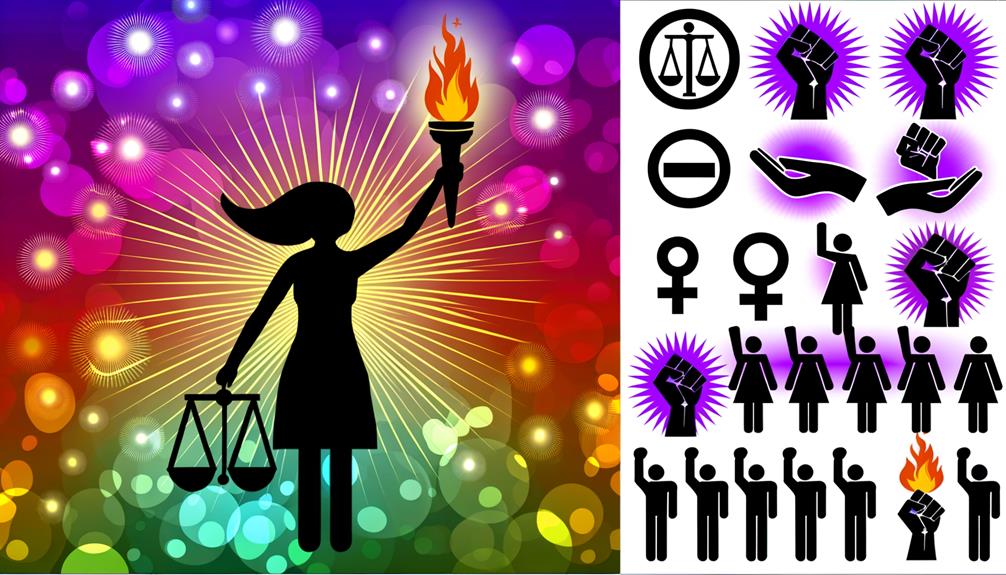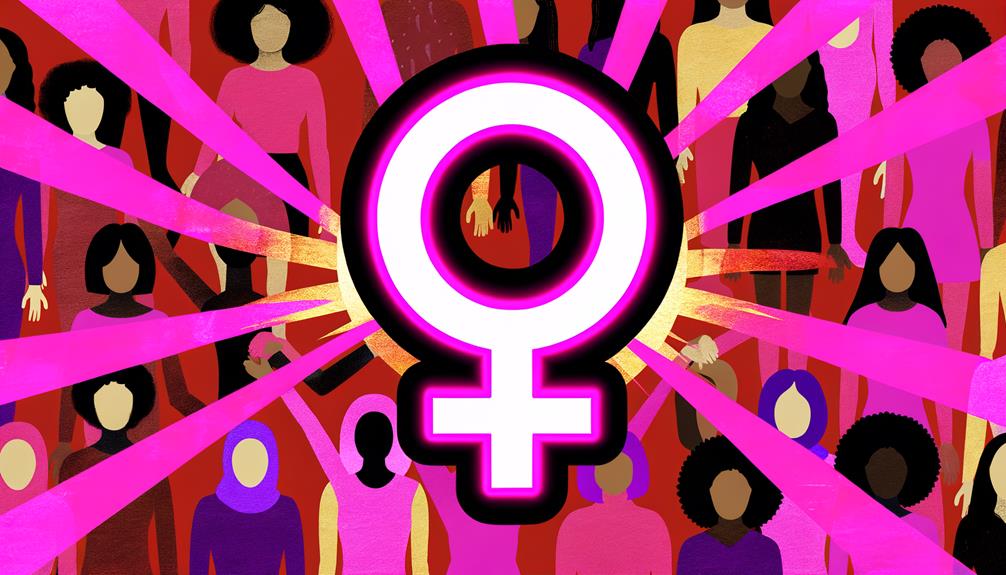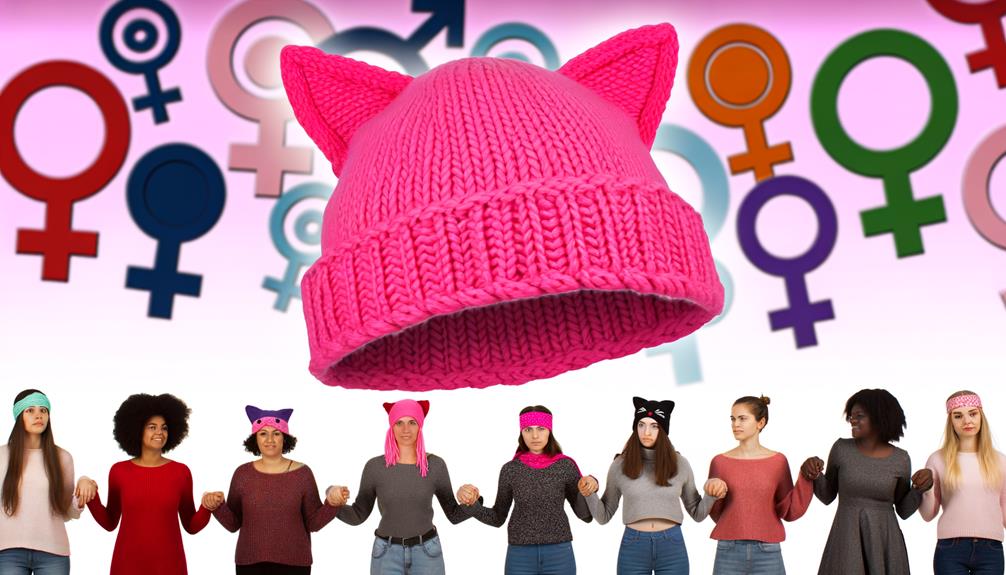Decoding Women Rights Symbols: A Guide to Meaning
Women's rights symbols, such as the Venus symbol, suffragette colors, and Rosie the Riveter, embody key narratives of female empowerment and gender equality. The Venus symbol ties ancient mythology to modern feminism, while suffragette colors—purple, white, and green—unify diverse advocacy groups.
Rosie the Riveter epitomizes female resilience in traditionally male roles. The feminist fist, originating from civil rights activism, signifies unity and strength, intersecting various social causes.
The Pink Pussyhat from the 2017 Women's March symbolizes collective resistance and solidarity. These symbols are interdisciplinary beacons, connecting cultural history, sociology, and activism.
Engage further to uncover deeper insights and connections.

Key Takeaways
- The Venus symbol represents femininity and women's rights advocacy, linking ancient mythology with modern social movements.
- Suffragette colors signify dignity, purity, and hope, uniting diverse groups within the women's rights movement for greater visibility.
- The Feminist Fist conveys strength, determination, and unity, symbolizing ongoing struggles against patriarchy.
- The Pink Pussyhat from the 2017 Women's March symbolizes feminist solidarity, resistance, and the intersection of craft and activism.
- Rosie the Riveter embodies female empowerment and resilience, advocating for gender equity in the workforce.
Venus Symbol

The Venus symbol, characterized by a circle atop a cross, has historically served as a potent representation of femininity and women's rights, intertwining elements of astronomy, mythology, and social advocacy.
Astronomically, it denotes the planet Venus, named after the Roman goddess of love and beauty, highlighting the symbol's mythological connections.
In feminist discourse, the symbol transcends its celestial origins, embodying the struggle and resilience of women advocating for equal rights. This interdisciplinary emblem bridges the gap between ancient mythological reverence and contemporary social movements.
Its enduring presence in feminist iconography underscores a critical analysis of how historical symbols are reappropriated to champion modern causes, facilitating a deeper understanding of gender dynamics and the continuous fight for equality.
Suffragette Colors
Building upon the potent symbolism of the Venus emblem, the suffragette colors—purple, white, and green—emerge as another significant facet of the women's rights movement, each hue meticulously selected to convey a powerful message of unity, purity, and hope for the future.
Purple, representing dignity and loyalty, underscores the movement's commitment to equality. White symbolizes purity, reflecting the moral high ground of the cause. Green, denoting hope, encapsulates the forward-looking aspirations of the suffragettes.
This chromatic triad not only unified diverse groups within the movement but also facilitated interdisciplinary alliances, intertwining sociopolitical activism with visual semiotics. The colors' strategic deployment in banners, attire, and publications amplified their visibility and impact, forging a cohesive identity that transcended national boundaries.
Rosie the Riveter
Rosie the Riveter stands as a seminal icon in the discourse of women's rights, symbolizing the cultural shift towards female empowerment during World War II.
Her imagery, characterized by strength and resilience, has left an indelible legacy in both historical and contemporary contexts, reinforcing the potential and capability of women in traditionally male-dominated fields.
This representation not only highlights the transformative power of visual symbols but also underscores the enduring relevance of gender equity in the workforce.
Cultural Impact and Legacy
Embodying the strength and resilience of women during World War II, Rosie the Riveter has left an indelible mark on cultural narratives and feminist iconography. Her legacy transcends simple wartime propaganda, influencing multiple spheres of society and continuing to inspire generations.
- Historical Significance: Represented the mobilization of women into the workforce during critical wartime.
- Feminist Iconography: Became a symbol for the feminist movements in the 1960s and beyond.
- Pop Culture: Frequently referenced in media, art, and literature, reinforcing her enduring presence.
- Economic Impact: Highlighted the critical role of women in sustaining industrial productivity.
- Educational Tool: Utilized in academic discussions on gender roles, labor history, and social change.
Rosie's image remains a potent symbol of empowerment and resilience.
Empowerment Through Imagery
The image of Rosie the Riveter serves as a powerful visual representation, encapsulating the ethos of female empowerment and resilience across various socio-political contexts. Emerging during World War II, Rosie symbolized the critical role women played in the workforce, challenging traditional gender roles and contributing to the war effort.
This iconography transcends its historical origin, influencing contemporary feminist movements and labor rights advocacy. The interdisciplinary significance of Rosie the Riveter encompasses sociology, gender studies, and visual culture, illustrating how imagery can galvanize collective action and foster identity formation.
Feminist Fist
Rooted in the struggle for gender equality, the Feminist Fist symbol encapsulates a powerful visual representation of resistance and solidarity among women. Historically, this symbol has evolved from its origins in labor movements and civil rights activism to become an emblem of feminist defiance.
The clenched fist, often intersected by the female gender symbol, underscores themes of empowerment, resilience, and unity.
Historical Significance: Originating from labor and civil rights activism.
Visual Power: The clenched fist conveys strength and determination.
Intersectionality: Represents the interconnected nature of social categorizations.
Global Reach: Adopted by feminist movements worldwide.
Cultural Resonance: Symbolizes ongoing struggles against patriarchy.
Through an interdisciplinary lens, the Feminist Fist continues to inspire collective action and advocate for systemic change.
Pink Pussyhat

The Pink Pussyhat, originating from the 2017 Women's March, serves as both a powerful visual statement and a critique of gender-based oppression.
Its cultural resonance continues to evolve, intersecting with contemporary discussions on feminism, solidarity, and the commodification of feminist symbols.
Analyzing its significance requires a multifaceted approach, considering historical context, media representation, and the broader socio-political landscape.
Origins and Significance
Emerging from the 2017 Women's March, the Pink Pussyhat has become a powerful emblem of feminist solidarity and resistance. Its origins lie in the grassroots mobilization of women worldwide, symbolizing unity and defiance against gender-based discrimination.
The hat's distinct pink color and cat-ear design evoke both traditional femininity and a reclamation of derogatory language, transforming vulnerability into strength.
- Symbol of Unity: Represents collective action and shared purpose among women.
- Reclaimed Identity: Converts a term of oppression into a badge of honor.
- Visibility: Creates a visually striking presence in protests and media.
- Craftivism: Embodies the intersection of craft and activism.
- Intergenerational Connection: Bridges generational gaps through shared activism and participation.
This multifaceted symbol underscores the intersectionality of contemporary feminist movements.
Cultural Impact Today
Building on its origins and significance, the Pink Pussyhat continues to exert a profound cultural impact by symbolizing ongoing struggles and achievements within contemporary feminist movements. This ubiquitous accessory, originating from the 2017 Women's March, has transcended its initial context to become an emblem of resistance and solidarity.
Through an interdisciplinary lens, the hat's prevalence in political demonstrations highlights its role in uniting diverse groups under a shared cause. Critically, it also invites discourse on inclusivity, considering debates around its representation of all women's experiences.
The Pink Pussyhat embodies a complex interplay of historical resonance and modern-day activism, serving as a visual shorthand for both unity and the nuanced challenges within feminist advocacy.
Equality Sign
An iconic representation of the struggle for gender parity, the equality sign encapsulates the essence of women's rights movements. This symbol, consisting of two parallel horizontal lines, transcends its simplistic design to embody complex ideological assertions. Its universality and minimalism make it a powerful emblem in various sociopolitical contexts.
- Historical Context: Rooted in the civil rights era, it underscores the ongoing fight for fair treatment.
- Legal Implications: Represents advocacy for laws that guarantee equal rights and opportunities.
- Cultural Resonance: Symbolizes the broader cultural shift towards gender inclusivity.
- Interdisciplinary Relevance: Engages scholars from sociology, law, and gender studies.
- Activism Catalyst: Serves as a rallying point for grassroots movements and public demonstrations.
Female Gender Sign

The female gender sign, characterized by a circle with a small cross beneath it, serves as a potent symbol of feminism and the enduring quest for gender equality. Its origins are deeply rooted in both astrological and alchemical traditions, where it symbolized the planet Venus and the element copper, respectively.
In a socio-political context, this glyph has transcended its ancient meanings to embody the collective struggle against systemic gender oppression. Interdisciplinary analysis reveals its cultural significance across various feminist movements, highlighting its role in advocacy, identity formation, and solidarity.
The symbol's simplicity and universality make it a powerful visual shorthand in the fight for women's rights, encapsulating the complexity of gender discourse in a single, evocative image.
She-Ra Symbol
Expanding on the theme of symbolic representation in the advocacy for women's rights, the She-Ra symbol presents another compelling icon within feminist and pop culture narratives. As a character originating from the 1980s animated series and later reimagined in contemporary media, She-Ra embodies strength, resilience, and leadership.
Her symbol, often depicted as a sword or emblem of power, transcends mere entertainment to resonate with broader societal themes.
- Empowerment: Represents women's strength and capability.
- Leadership: Symbolizes female leadership in traditionally male-dominated roles.
- Equality: Advocates for gender equality through heroic narratives.
- Resilience: Portrays overcoming adversity and challenges.
- Inspiration: Motivates young audiences to aspire to greatness regardless of gender.
This multifaceted symbol contributes to ongoing feminist discourse.
Conclusion
The evolution of women's rights symbols reflects a rich tapestry of social, political, and cultural movements.
Evidently, the inclusion of the Venus symbol, suffragette colors, Rosie the Riveter, the feminist fist, the pink pussyhat, the equality sign, the female gender sign, and the She-Ra symbol, demonstrates the multifaceted struggle for gender equality.
An intriguing statistic reveals that women comprised 57.4% of the labor force in 2020, underscoring the ongoing relevance of these symbols in advocating for women's rights.





